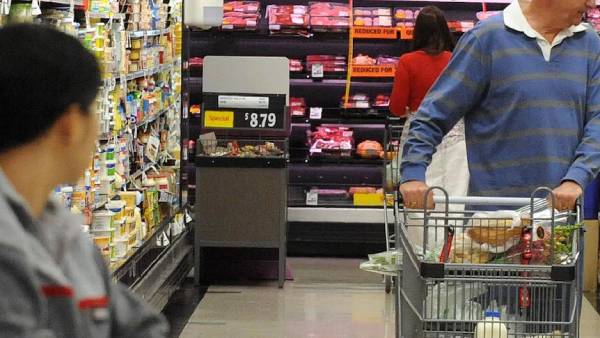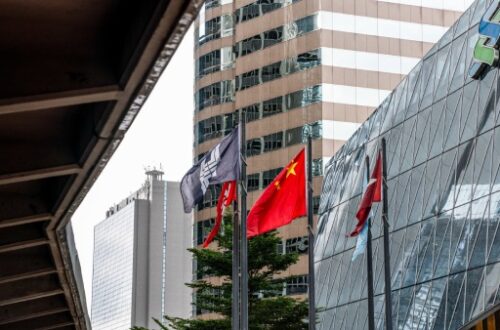
China’s retail deals beat predictions in October, regardless of property market drop
- October retail deals developed by 4.9% from a year prior, beating a Reuters’ survey determining 3.5% development.
- From January to October, fixed resource speculation rose by 6.1% from a year prior, somewhat not exactly the 6.2% ascent projected in a Reuters’ survey.
- China’s economy has face a few difficulties this year — from more slow than-anticipated shopper spending to troublesome floods taking steps to disturb supply chains.
A worker orchestrates vegetables at a grocery store in the Congtai District on November 10, 2021 in Handan, Hebei Province, China.
Retail deals in October rose 4.9% from a year prior, beating a Reuters survey that anticipated 3.5% development and quicker than the 4.4% expansion in September.
China’s retail deals rose more than anticipated in October, even as fixed resource venture stayed drowsy, as indicated by information delivered Monday by the National Bureau of Statistics.
The surprisingly good retail deals in October went inside a month, beginning with China’s last significant occasion of the schedule year. Be that as it may, critical drivers for retail deals, for example, vehicles and dress fell in October contrasted with a year prior.
October retail deals developed by 4.9% from a year prior, beating a Reuters’ survey guaging 3.5% development, and quicker than the 4.4% ascent in September.
From January to October, fixed resource speculation rose by 6.1% from a year prior, somewhat not exactly the 6.2% ascent projected in a Reuters’ survey.
Consistently, interest in fixed resources declined because of a 5.4% year-on-year decrease in land speculation last month, as per Tommy Wu, a main financial analyst at Oxford Economics.
Modern creation likewise beat assumptions, a 3.5% year-on-year expansion in October. Reuters had anticipated a development of 3%.
“Monetary force stayed feeble in October, with the land slump burdening industry and another rush of Covid episodes hosing family utilization,” Wu said. He anticipates that the downturn in property should be contained, yet at the same time haul down development in modern creation.
Modern creation additionally beat assumptions, rising 3.5% y/y in October. figure a 3% ascent.
“While power deficiencies and creation cuts hampered creation toward the beginning of October, we don’t think they are a critical issue any longer, following a progression of strategy measures to build coal creation and lower coal costs,” Wu said.
Property area
Over the most recent two years, Chinese controllers have tried to lessen the land business’ dependence on obligation for development.
Costs for new homes in more than 50 of 70 significant Chinese urban communities declined in October from the earlier month, the insights department said Monday.
Significant land designers like Evergrande have wavered near the very edge of default, raising worries among worldwide financial backers about expected aftermath on the planet’s second-biggest economy. Property represents about a fourth of China’s GDP.
In spite of the new droop in land, which represents the main part of family abundance, the representative for the National Bureau of Statistics, Fu Linghui, guaranteed Monday that the property market stayed stable by and large and noted expansions in floor space sold.
Inflationary tensions in China
China’s metropolitan joblessness stayed stable in October from 4.9% in the earlier month. Joblessness for individuals between the ages of 16 and 24 stayed a lot higher at 14.2%, though marginally lower than 14.6% in September.
The sharp ascent in product costs has raised worries about stagflation, a monetary peculiarity wherein costs rise yet business action deteriorates, prompting high joblessness and lower shopper buying power.
China’s economy has confronted a few different difficulties this year — from more slow than-anticipated buyer spending to floods and power deficiencies taking steps to disturb worldwide stockpile chains.
While “it appears as though there are a few indications of stagflation,” the circumstance is brought about by momentary variables, Fu said in Mandarin.
Looking forward, there is still vulnerability not too far off. China’s quest for a “zero resistance” strategy to control the Covid pandemic has restricted travel in the country. Beijing’s broad administrative mediations focusing on areas, incorporating Internet organizations with supposed monopolistic conduct, likewise burden business feeling.
China’s purchaser value list (CPI) rose 1.5% in October from a year prior, while the maker value record (PPI) rose 13.5%, the quickest beginning around 1995.
Regardless of whether rising maker costs cause purchaser costs to expand, “we don’t figure CPI swelling will rise enough to turn into a major issue for financial arrangement,” Wu said. He expects the maker value file to fall fundamentally one year from now, somewhat on facilitating limitations on item supply.
Solid commodity development has stayed a splendid spot for the Chinese economy. Public GDP is as yet poised to surpass the IMF’s worldwide development forecast of 5.9%.
Mia is a literature author. Mia was not interested in becoming a writer when she was a child, a fact which she himself admits that separates her from fellow writers she has met. As a young adult, Mia did not know what she wanted to be. she remembered, however, how in high school, she had been a class clown, and that made her decide to become a books writer. Later on, she moves toward the writing news articles. In recent she writes her news on Stock Invests.
Disclaimer: The views, suggestions, and opinions expressed here are the sole responsibility of the experts. No STOCK INVESTS journalist was involved in the writing and production of this article.





